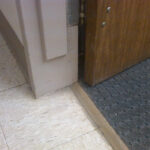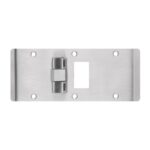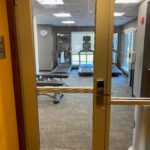 When someone asks what I do for a living, it strikes me funny that most of my job is related to a couple of chapters of the International Building Code, a portion of NFPA 101 – The Life Safety Code, and a few other codes and referenced standards. People find it hard to believe that door hardware is so complicated that it requires dedicated door hardware consultants to get the right stuff on the door…my current role is focused on just a sliver of the door-hardware pie, which is almost invisible in the context of the overall building design.
When someone asks what I do for a living, it strikes me funny that most of my job is related to a couple of chapters of the International Building Code, a portion of NFPA 101 – The Life Safety Code, and a few other codes and referenced standards. People find it hard to believe that door hardware is so complicated that it requires dedicated door hardware consultants to get the right stuff on the door…my current role is focused on just a sliver of the door-hardware pie, which is almost invisible in the context of the overall building design.
With that said, it’s more than a full-time job for me to keep up with the requirements of the model codes and referenced standards – helping to interpret and apply them, updating them, and teaching people about them. This leaves me little or no time to become familiar with every state and local requirement that applies to door openings. When I receive a state-specific question, I attempt to locate the state code online, look at which model code has been adopted, and then check for state code modifications to a specific section. This works most of the time.
When it comes to local requirements, or guidelines of the many agencies within a jurisdiction, it’s impossible for me to be familiar with every publication. I rely on our local SSCs and especially my list of “Code Champions” to know what’s-what on the local level. In many cases, there are also distributors, architects and specifiers, code officials, and others who are my go-to people within each jurisdiction.
The perfect example presented itself the other day. Rick Nemec of Opening Specialists asked me if there is a requirement stating that boiler rooms in schools must have inswinging doors (coincidentally, someone asked me the same question yesterday). I had not heard of this requirement, and in fact, I’ve heard that some jurisdictions may require boiler-room doors to be outswinging and possibly even have panic hardware.
As it turns out, there IS a requirement in this project’s jurisdiction for boiler-room doors in schools to swing into the boiler room – it’s in a 134-page document called the Health/Life Safety Glossary For Existing Public School Buildings in Illinois (excluding Chicago Public Schools). The publication is from the Illinois State Board of Education, and I only found out about it because Rick sent it to me. This page has more information about the inspections in Illinois as well as links to download the glossary and checklist.
My point is that just when you think you have a good handle on things, another requirement pops up. I can’t know everything – none of us can – so we need to be on the lookout for these local requirements as well as keeping up with the model codes, referenced standards, and state code modifications. I’m counting on you!
And one more thing – especially for those of you working with schools in Illinois. This document contains a section on classroom security, which requires the following:
93. Inside of Classroom Doors Unlocked (IFC15: 1031.2; IFC09: 1030.2; IFC06/03: 1027; BOCA-F: 605)
Classroom egress doors must be easily and readily openable by pupils from the inside without the use of a key or special knowledge or effort. Bolt locks are not permitted. Unlatching of the door should not require more than one motion. Any additional locking devices that impede opening of doors are not permitted. [See Appendix N for more information]
If requiring compliance with the model codes wasn’t enough, this document makes it very clear which types of locks are allowed (and which are not). Appendix N includes additional information specific to classroom door locking hardware, including photos of non-compliant security devices as well as this paragraph:
The issue of code-compliant locking of door within a school room (and this applies to all doors to rooms that are normally occupied, not just classrooms) is still an active conversation throughout public schools in Illinois. ISBE, Office of the State Fire Marshal (OSFM), and IARSS are diligently working together to keep the state’s Regional Offices of Education up to date on this security locking issue. Acts of violence in schools have caused questions as to code-compliant locking systems in schools.. Unfortunately there is still pressure from non-school, non-fire service vendors that these security locking systems should be used in public schools. The majority of the security locking systems seen by ISBE, OSFM, and IARSS do not comply with the School Code. To make matters worse, schools are purchasing these systems without confirming first that they are allowed to be used.
The Illinois BOE publication also requires glazing installed after January 1, 1973 to be safety glazing, and includes some requirements for time-out rooms. Good stuff!
Does your state Board of Education publish a set of guidelines like the ones used in Illinois? I’d love to see them!
Thank you to Rick Nemec for inspiring this blog post! 😀
You need to login or register to bookmark/favorite this content.






I also noted the “… openable by pupils …” wording, which in my mind emphasizes how the operation needs to be simple and commonplace
I agree!
– Lori
Note that illinois has different codes for new vs existing schools. The code you mentioned is for existing schools but if a new school is built you only reference the IBC.
Good point! Thanks!
– Lori